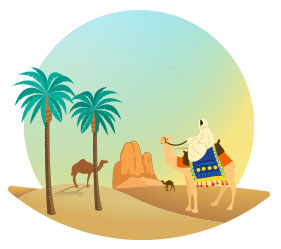Umm Farwa Bint Abi Quhafa
Umm Farwa Bint Abi Quhafa (1): Umm Farwa Bint Abi Quhafa was the sister of Abu Bakr Al-Siddiq, may Allah be pleased with him. Her mother was Hind Bint Nufayl (or “Nuqayd,” according to some sources) Bin Bujair Bin Abd Bin Qusai, whose mother was Umm Farwa Bint Abi Jundub Bin Rawaha of the tribe of Huthail.
Umm Farwa Bint Abi Quhafa was married to Tamim Bin Aws Al-Dari of Bani Abd Al-Dar Bin Hani Bin Nimarah of the tribe of Lakhm. When Tamim (who was her first husband) divorced her, she married Abu Umama Bin Abdullah Al-Bajli, after which she married Abu Umayah Bin Al-Harith Al-Azdi of Bani Al-Saqbi, whose lineage can be traced to Saqb Bin Dahman Bin Nasr Bin Al-Harith. She bore Abu Umayah a girl named Umaima, who married Abdullah Bin Al-Zubayr. Umm Farwa then married Al-Ash’ath Bin Qais Al-Kindi and bore him: Muhammad, Ishaq, Isma’il, Qurayba, Habbaba, and Jaada.
Source: Kitab Al-Sulala Al-Bakria As-Siddiqia – Part II, by Ahmed Farghal Al-De’abassi Al-Bakri
Date of Publication
1 Ramadan 1438 AH / May 26, 2017 AD
(1) Al-Muhbar, by Ibn Habib 1/ 452, Al-Manaqib Al-Mazidiyah fi Akhbar Al-Muluk Al-Asadiyah 1/ 78, Al-Muntatham fi Tarikh Al-Mulouk wa Al-Umam 4/ 87, Al-Isti’ab fi Ma’rifat Al-Ashab 1/ 134, Usdul Ghabah, El-Elmia Ed. 7/ 366, Al-Isaba fi Tamyiz Al-Sahaba 7/18, Futuh Al-Buldan 1/ 106, Musnad Ahmad, Al-Risala Ed. 44/ 518, Al-Mu'jam Al-Kabeer, by Al-Tabarani 24/ 88, Marefat Al-Sahaba, by Abi Nu’aym 1/ 74, Al-Tabieen fi Ansab Al-Qurashieen 1/ 282-283, A’lam Al-Nissa’ fi ‘Alami Al-Arab wa Al-Islam 4/ 160
